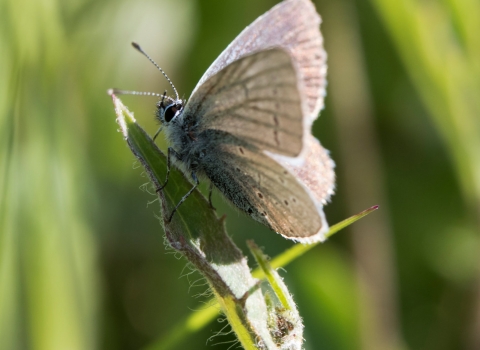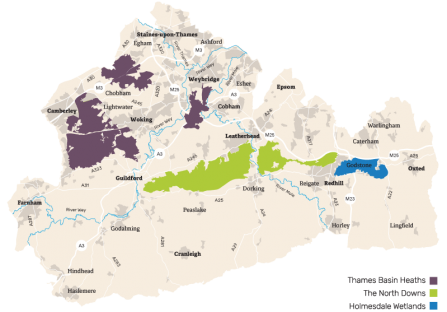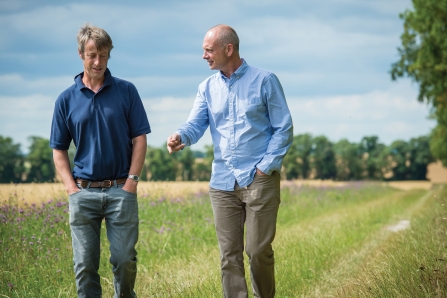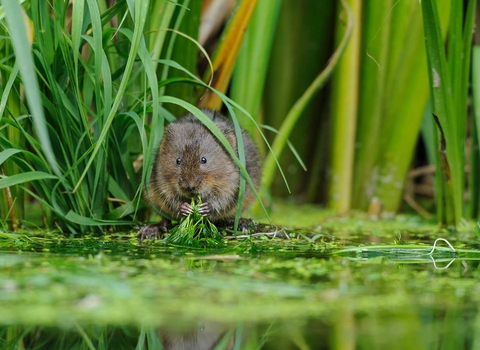Restoring Surrey’s Nature
In Surrey and across the country, nature is becoming increasingly confined to small fragmented areas with little or no connectivity between them. This is a major reason for why wildlife is declining. A third of Surrey’s biodiversity is either locally extinct or heading that way. The cause of this habitat fragmentation is past and present land management as well as decisions about land-use and development, which must all be addressed.
For nature to thrive we need to create a ‘living landscape’ across Surrey. Working in partnership, we are focussing on key areas of the county to maximise our impact on the ground. These are called ‘Biodiversity Opportunity Areas’ or BOAs.

© Chris Lawrence
BOA Goals
To improve the status of SSSIs with a further 50% reaching favourable condition.
To have 50% of Sites of Nature Conservation Importance or local wildlife sites enter into positive management.
To deliver specific habitat creation or restoration targets relevant to that BOA.
To develop specific species targets that are relevant to that habitat.
To increase the connectivity within, and between, BOAs.
Surrey's BOAs
The BOAs that we have chosen to concentrate on for the next five years are marked on the map below. They include three areas in the Thames Basin Heaths, two in the North Downs, as well as the Holmesdale Wetlands.

Key habitat targets
The Government’s 25 Year Environment Plan sets out why we need to create a national Nature Recovery Network. To realise our part in this at a county level we are focusing our work in a prioritised set of Surrey’s Biodiversity Opportunity Areas, that will eventually be part of the Nature Recovery Network and where we feel we can make the most impact using our finite resources for the next five years.
Although Surrey’s other BOAs are also important, our selection process has prioritised those where the Trust already has a good deal of influence over the management of the land, from which we can extend our reach. In each area, our aim is to unite a group of land managers who can work together to achieve the space that nature so desperately needs.
Thames Basin Heaths
Lowland Heath is one of the rarest habitats in the UK. Less than 200 years ago, much of the west of Surrey would have been heathland. This habitat is now highly fragmented by development and it is vital that we protect what is left and restore as much as we can.
Given multiple constraints these targets will not be easy to achieve. The key opportunity to achieve the heathland restoration target is in the Wisley and Ockham area.
Key habitat targets |
|---|
|
Restore or create a further 60 hectares of heathland / acid grassland |
|
Create a further 4 hectares of wet woodland |
|
Restore or create a further 7 hectares of fen |
The North Downs
The iconic North Downs between Guildford and Reigate form our second pair of priority BOAs and form part of the Surrey Hills Area of Outstanding Natural Beauty. We are working to support and develop the existing land management partnership in the west of this area to deliver our targets. This includes local farmers and land managers, the National Trust and the Surrey Hills AONB.
North Downs targets |
|---|
|
Create or restore 24 hectares of chalk grassland |
|
Restore 4 hectares of beech and yew woodland |
|
An increase in 35% of mixed woodland being actively managed |
|
Create or rejuvenate 4.75 kilometres of hedgerows |
Holmesdale
Holmesdale presents an opportunity to work with the aggregate industry and other partners to restore threatened areas of wetland.
Our approach starts by focusing on restoring the ecological integrity of our Bay Pond reserve, much of which is a SSSI. This requires us to work with land managers and communities upstream to reduce sediment and nutrients flowing into the pond.
Holmesdale targets |
|---|
|
Create or restore 7 hectares of floodplain grazing marsh |
|
Create 2 hectares of standing open water |
|
Create or restore 3 hectares of reedbeds |
|
Create or restore 9 hectares of heathland / acid grassland |
|
Create or rejuvenate 2 kilometres of hedgerow |

© Jon Hawkins - Surrey Hills Photography
Science has to be at the heart of our decision making
Research and monitoring
As a conservation organisation, science has to be at the heart of our decision making. We will work with the University of Surrey and other research partners to find the long term solutions that nature so badly needs in our county.
There are five strands to this work:
- Understanding the pressures on biodiversity and how people benefit from the natural environment.
- Discovering better ways to manage the environment to improve biodiversity and improve public understanding and individual wellbeing.
- Create partnerships which develop knowledge for both practical application and scientific advancement.
- To better demonstrate our ecological and social impact.
- Grow our citizen science programme.

© Tom Marshall
Working in partnership
The reserves we look after are safe havens for wildlife. But the 5% of Surrey’s land that these represent is not enough if we are to recover Surrey’s nature. We clearly need to do more to change outcomes across the other 95%.
The answer isn’t simply to increase the scale of the land we manage, although we will continue to deliver our mission on the land we are responsible for.
The solution is to expand our work with other land managers on their estates, sharing our knowledge and skills to create a more joined up landscape.
This means restoring more habitats and creating green corridors between nature reserves. It also means working with local people and inspiring them to protect nature. This is known as a ‘living landscape’.
The aspiration is that by 2023, we will be in a position to move onto a further set of BOAs, safe in the knowledge that those where we have been working will have committed land managers who are acting for wildlife.


